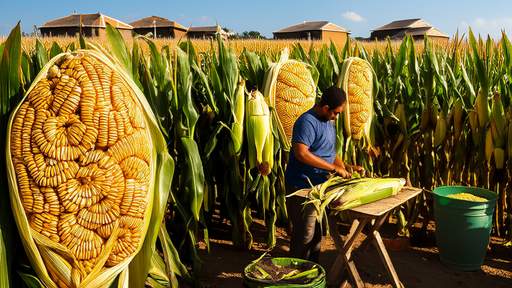The dining table holds a special significance for our silver-haired generation. As we age, our nutritional needs evolve in ways that often go unnoticed until deficiencies manifest. The interplay between aging physiology and dietary requirements creates a complex landscape that demands our attention—not just from healthcare providers, but from families and caregivers who share meals with older adults daily.
Beneath the surface of every lovingly prepared meal for elderly parents or grandparents lies a silent challenge: the body's diminishing capacity to absorb and utilize nutrients with the same efficiency as younger years. This biological shift occurs alongside changing taste perceptions, dental challenges, and sometimes reduced appetite, creating a perfect storm for nutritional gaps. What appears as simple pickiness or small portions might actually signal deeper physiological changes requiring dietary adaptation.
The calcium paradox presents one of the most striking examples of nutritional challenges in aging. While dairy products remain abundant in many elderly diets, vitamin D levels—critical for calcium absorption—often plummet due to reduced sun exposure and the skin's declining ability to synthesize this vital nutrient. The result? Consuming calcium-rich foods without addressing vitamin D status becomes akin to pouring water into a leaking bucket. This disconnect explains why osteoporosis remains prevalent even among seniors who conscientiously drink their milk.
Protein represents another silent crisis in elderly nutrition. The gradual loss of muscle mass known as sarcopenia accelerates after sixty, yet traditional senior diets frequently emphasize soft, easy-to-chew carbohydrates over protein-rich foods that require more chewing. The cultural emphasis on light evening meals further exacerbates this issue, often leaving older adults without adequate protein during their last meal of the day when muscle repair occurs. This nutritional shortfall manifests not as immediate hunger, but as gradual weakness, increased falls, and prolonged recovery from illness.
Hydration deserves particular attention in discussions of elderly nutrition. The aging body's thirst mechanism becomes less reliable, and the kidneys lose some capacity to concentrate urine. What begins as mild dehydration can spiral into confusion, urinary tract infections, or even hospitalization—often misinterpreted as cognitive decline rather than what it truly represents: the body's cry for water. The solution seems simple, yet implementing consistent hydration habits proves challenging for many older adults, especially those concerned about nighttime bathroom trips or managing incontinence.
B vitamins—particularly B12—tell perhaps the most insidious nutritional story of aging. As stomach acid production decreases, a process that begins as early as our thirties, the body loses its ability to liberate B12 from food proteins efficiently. The paradox? Blood tests might show normal B12 levels while cellular deficiency persists, masquerading as dementia, neuropathy, or depression. This disconnect between blood values and tissue status explains why some cognitively impaired patients show remarkable improvement with B12 injections despite "normal" blood work.
The antioxidant puzzle presents another layer of complexity. While fruits and vegetables remain important throughout life, the aging body faces increased oxidative stress while simultaneously absorbing certain antioxidants less efficiently. The vibrant produce that once provided ample protection now requires strategic pairing—vitamin C with iron-rich plant foods, healthy fats with carotenoids—to overcome absorption hurdles. This isn't about eating more, but rather eating smarter to compensate for physiological changes.
Cultural and psychological factors further complicate nutritional adequacy. The depression-era mentality of cleaning one's plate clashes with reduced caloric needs, potentially leading to weight gain despite micronutrient deficiencies. Conversely, the loneliness that often accompanies aging can suppress appetite in those who once found joy in shared meals. The dining table transforms from a place of nourishment to a reminder of loss—of spouses, of family meals, of the vibrant flavors dulled by aging taste buds.
Practical solutions exist at the intersection of nutrition science and compassionate care. Fortifying familiar foods proves more effective than introducing foreign "health foods"—adding powdered milk to mashed potatoes, blending vegetables into favorite soups, or using eggs as a protein vehicle. Small, nutrient-dense meals offered frequently often succeed where three large meals fail. Perhaps most importantly, shared mealtimes provide both social stimulation and the opportunity to discreetly monitor intake without creating feelings of surveillance or infantilization.
The silver-haired dinner table tells a story far beyond what's on the plate. It reflects the biological realities of aging, the psychological journey of later life, and the cultural values surrounding food and care. Addressing elderly nutritional needs requires equal parts scientific understanding and human compassion—recognizing that the best dietary intervention means little if it arrives without dignity, or if it fails to account for the complex person behind the nutritional requirements.

By /Jun 6, 2025

By /Jun 5, 2025

By /Jun 5, 2025

By /Jun 5, 2025

By /Jun 5, 2025

By /Jun 5, 2025

By /Jun 5, 2025

By /Jun 5, 2025

By /Jun 5, 2025

By /Jun 5, 2025

By /Jun 5, 2025

By /Jun 5, 2025

By /Jun 5, 2025

By /Jun 5, 2025

By /Jun 5, 2025

By /Jun 5, 2025

By /Jun 5, 2025

By /Jun 5, 2025

By /Jun 5, 2025

By /Jun 5, 2025